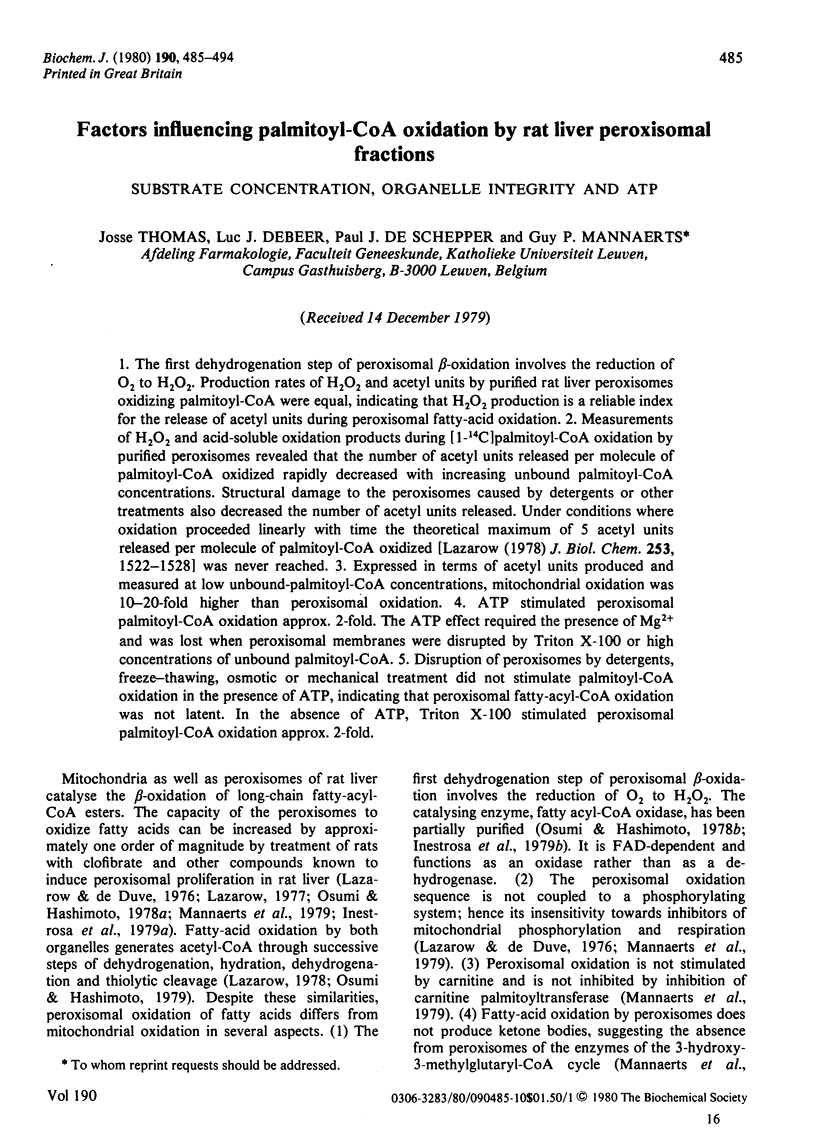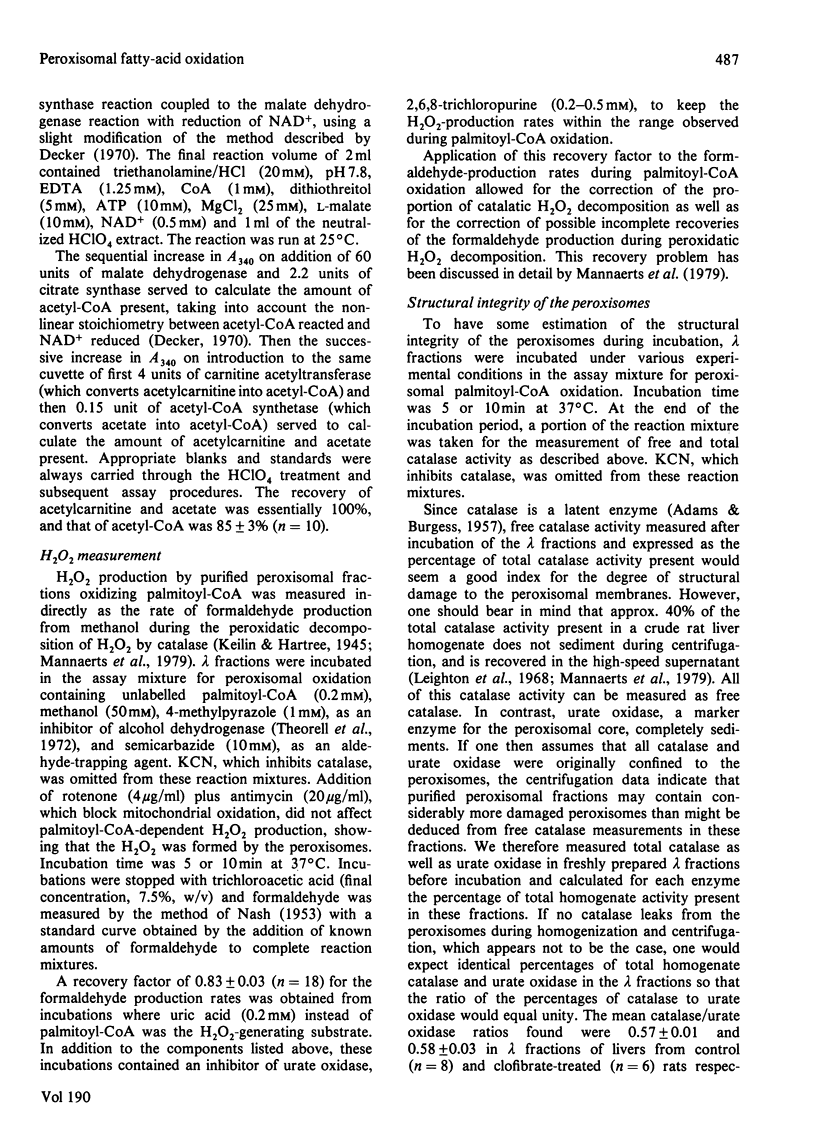Abstract
1. The first dehydrogenation step of peroxisomal beta-oxidation involves the reduction of O2 to H2O2. Production rates of H2O2 and acetyl units by purified rat liver peroxisomes oxidizing palmitoyl-CoA were equal, indicating that H2O2 production is a reliable index for the release of acetyl units during peroxisomal fatty-acid oxidation. 2. Measurements of H2O2 and acid-soluble oxidation products during [1-14C]palmitoyl-CoA oxidation by purified peroxisomes revealed that the number of acetyl units released per molecule of palmitoyl-CoA oxidized rapidly decreased with increasing unbound palmitoyl-CoA concentrations. Structural damage to the peroxisomes caused by detergents or other treatments also decreased the number of acetyl units released. Under conditions where oxidation proceeded linearly with time the theoretical maximum of 5 acetyl units released per molecule of palmitoyl-CoA oxidized [Lazarow (1978) J. Biol. Chem. 253, 1522--1528] was never reached. 3. Expressed in terms of acetyl units produced and measured at low unbound-palmitoyl-CoA concentrations, mitochondrial oxidation was 10--20-fold higher than peroxisomal oxidation. 4. ATP stimulated peroxisomal palmitoyl-CoA oxidation approx. 2-fold. The ATP effect required the presence of Mg2+ and was lost when peroxisomal membranes were disrupted by Triton X-100 or high concentrations of unbound palmitoyl-CoA. 5. Disruption of peroxisomes by detergents, freeze--thawing, osmotic or mechanical treatment did not stimulate palmitoyl-CoA oxidation in the presence of ATP, indicating that peroxisomal fatty-acid-CoA oxidation was not latent. In the absence of ATP, Triton X-100 stimulated peroxisomal palmitoyl-CoA oxidation approx. 2-fold.
Full text
PDF









Selected References
These references are in PubMed. This may not be the complete list of references from this article.
- ADAMS D. H., BURGESS E. A. The effect of the degree of homogenization on the catalase activity of liver homogenates. Br J Cancer. 1957 Jun;11(2):310–325. doi: 10.1038/bjc.1957.39. [DOI] [PMC free article] [PubMed] [Google Scholar]
- Baudhuin P., Beaufay H., Rahman-Li Y., Sellinger O. Z., Wattiaux R., Jacques P., De Duve C. Tissue fractionation studies. 17. Intracellular distribution of monoamine oxidase, aspartate aminotransferase, alanine aminotransferase, D-amino acid oxidase and catalase in rat-liver tissue. Biochem J. 1964 Jul;92(1):179–184. doi: 10.1042/bj0920179. [DOI] [PMC free article] [PubMed] [Google Scholar]
- Chen R. F. Removal of fatty acids from serum albumin by charcoal treatment. J Biol Chem. 1967 Jan 25;242(2):173–181. [PubMed] [Google Scholar]
- Christiansen R. Z. The effect of clofibrate-feeding on hepatic fatty acid metabolism. Biochim Biophys Acta. 1978 Sep 28;530(3):314–324. doi: 10.1016/0005-2760(78)90151-0. [DOI] [PubMed] [Google Scholar]
- Hryb D. J., Hogg J. F. Chain length specificities of peroxisomal and mitochondrial beta-oxidation in rat liver. Biochem Biophys Res Commun. 1979 Apr 27;87(4):1200–1206. doi: 10.1016/s0006-291x(79)80034-0. [DOI] [PubMed] [Google Scholar]
- Inestrosa N. C., Bronfman M., Leighton F. Detection of peroxisomal fatty acyl-coenzyme A oxidase activity. Biochem J. 1979 Sep 15;182(3):779–788. doi: 10.1042/bj1820779. [DOI] [PMC free article] [PubMed] [Google Scholar]
- Inestrosa N. C., Bronfman M., Leighton F. Properties of fatty acyl-CoA oxidase from rat liver, a peroxisomal flavoprotein. Life Sci. 1979 Sep 24;25(13):1127–1135. doi: 10.1016/0024-3205(79)90134-6. [DOI] [PubMed] [Google Scholar]
- Keilin D., Hartree E. F. Properties of catalase. Catalysis of coupled oxidation of alcohols. Biochem J. 1945;39(4):293–301. [PMC free article] [PubMed] [Google Scholar]
- Lazarow P. B., De Duve C. A fatty acyl-CoA oxidizing system in rat liver peroxisomes; enhancement by clofibrate, a hypolipidemic drug. Proc Natl Acad Sci U S A. 1976 Jun;73(6):2043–2046. doi: 10.1073/pnas.73.6.2043. [DOI] [PMC free article] [PubMed] [Google Scholar]
- Lazarow P. B. Rat liver peroxisomes catalyze the beta oxidation of fatty acids. J Biol Chem. 1978 Mar 10;253(5):1522–1528. [PubMed] [Google Scholar]
- Lazarow P. B. Three hypolipidemic drugs increase hepatic palmitoyl-coenzyme A oxidation in the rat. Science. 1977 Aug 5;197(4303):580–581. doi: 10.1126/science.195342. [DOI] [PubMed] [Google Scholar]
- Leighton F., Coloma L., Koenig C. Structure, composition, physical properties, and turnover of proliferated peroxisomes. A study of the trophic effects of Su-13437 on rat liver. J Cell Biol. 1975 Nov;67(2PT1):281–309. doi: 10.1083/jcb.67.2.281. [DOI] [PMC free article] [PubMed] [Google Scholar]
- Leighton F., Poole B., Beaufay H., Baudhuin P., Coffey J. W., Fowler S., De Duve C. The large-scale separation of peroxisomes, mitochondria, and lysosomes from the livers of rats injected with triton WR-1339. Improved isolation procedures, automated analysis, biochemical and morphological properties of fractions. J Cell Biol. 1968 May;37(2):482–513. doi: 10.1083/jcb.37.2.482. [DOI] [PMC free article] [PubMed] [Google Scholar]
- Mannaerts G. P., Debeer L. J., Thomas J., De Schepper P. J. Mitochondrial and peroxisomal fatty acid oxidation in liver homogenates and isolated hepatocytes from control and clofibrate-treated rats. J Biol Chem. 1979 Jun 10;254(11):4585–4595. [PubMed] [Google Scholar]
- Markwell M. A., Bieber L. L., Tolbert N. E. Differential increase of hepatic peroxisomal, mitochondrial and microsomal carnitine acyltransferases in clofibrate-fed rats. Biochem Pharmacol. 1977 Sep 15;26(18):1697–1702. doi: 10.1016/0006-2952(77)90147-2. [DOI] [PubMed] [Google Scholar]
- NASH T. The colorimetric estimation of formaldehyde by means of the Hantzsch reaction. Biochem J. 1953 Oct;55(3):416–421. doi: 10.1042/bj0550416. [DOI] [PMC free article] [PubMed] [Google Scholar]
- Osumi T., Hashimoto T. Acyl-CoA oxidase of rat liver: a new enzyme for fatty acid oxidation. Biochem Biophys Res Commun. 1978 Jul 28;83(2):479–485. doi: 10.1016/0006-291x(78)91015-x. [DOI] [PubMed] [Google Scholar]
- Osumi T., Hashimoto T. Enhancement of fatty acyl-CoA oxidizing activity in rat liver peroxisomes by di-(i-ethylhexyl)phthalate. J Biochem. 1978 May;83(5):1361–1365. doi: 10.1093/oxfordjournals.jbchem.a132044. [DOI] [PubMed] [Google Scholar]
- Osumi T., Hashimoto T. Subcellular distribution of the enzymes of the fatty acyl-CoA beta-oxidation system and their induction by di(2-ethylhexyl)phthalate in rat liver. J Biochem. 1979 Jan;85(1):131–139. doi: 10.1093/oxfordjournals.jbchem.a132302. [DOI] [PubMed] [Google Scholar]
- Theorell H., Chance B., Yonetani T., Oshino N. The combustion of alcohol and its inhibition by 4-methyl-pyrazole in perfused rat livers. Arch Biochem Biophys. 1972 Aug;151(2):434–444. doi: 10.1016/0003-9861(72)90519-x. [DOI] [PubMed] [Google Scholar]


